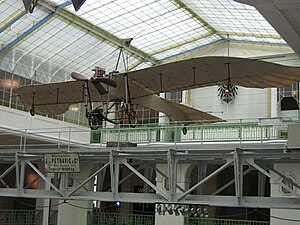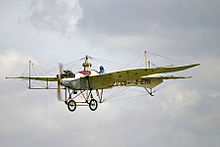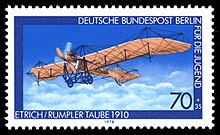Etrich Taube
| Etrich II dove | |
|---|---|

|
|
| Type: | Training and reconnaissance aircraft |
| Design country: | |
| Manufacturer: | |
| First flight: |
April 6, 1910 |
| Commissioning: |
1910 |
| Production time: |
1910 to 1918 |
| Number of pieces: |
246 (exact number unknown, probably significantly more) |
| Etrich-Rumpler pigeon | ||
|---|---|---|
| description | ||
| use | School, reconnaissance and bomb aircraft | |
| crew | 2 | |
| General data | ||
| length | 33.5 ft | 9.9 m |
| span | 45.83 ft | 14.3 m |
| height | 10.5 ft | 3.2 m |
| Wing area | 280 ft² | 32.5 m² |
| Weight | ||
| Empty mass | 950 lb | 650 kg |
| Max. Takeoff mass | 1200 lb | 850 kg |
| engine | ||
| engine | 4-cylinder Argus or 6-cylinder Mercedes type E4F |
|
| power | 74 kW | 100 hp |
| power | ||
| Top speed | 60 mph | 100 km / h |
| Service ceiling | 10,000 ft | 3000 m |
| Range | 140 km | |
| Armament | ||
| Armament | Rifles and pistols | |
| Bombs | Hand dropped bombs (2 kg) | |
The Etrich Taube , often also called Etrich II Taube in literature , is an aircraft developed by the Austrian aviation pioneer Igo Etrich . The aircraft of this type built by the Rumpler works in Berlin were also marketed under the name Rumpler Taube . It is one of the first types of aircraft to be built in large numbers.
history
After several years of development, Etrich completed the Etrich I in 1909 . It was created by converting a tail and hullless glider and "flew on November 29, 1909 over the entire length of the airfield in Wiener Neustadt ". In the winter of 1909/1910, the sum of his experiences resulted in the new design of the Etrich II Taube , a motorized airplane with a fuselage, which made its first flight on April 6, 1910.
Karl Illner , an employee of Etrich, won the price for the first flight from Vienna to Horn and back on a pigeon in October 1910 .
Etrich founded the Etrich-Flieger-Werke in Lubawka (then Liebau in Silesia) on February 28, 1912 , where Heinkel was also employed as a designer. On August 24, 1913, a pigeon flew over the Giant Mountains for the first time - Etrich flew with his pilot from Liebau in an arc over the mountains to Upper Old Town (today Horní Staré Město , a district of Trutnov ), where he came from, and immediately back to Liebau.
The aircraft was later built under license by Rumpler-Werke in Germany under the name Rumpler-Taube . The Rumpler-Werke stopped paying the license fees after a short time. Igo Etrich considered a lawsuit, which he dropped because of the expected length of the proceedings and the outbreak of the First World War . He released the prototype, whereupon more than 40 companies manufactured variants of this type under their own names. The pigeon was used in Germany , Italy and Austria-Hungary .
technology
The aircraft was a monoplane with external wire bracing and an auxiliary spar ("bridge") running under the wing. It had no ailerons and no wing flaps . It was controllable in all three axes by twisting the surface . The chassis was steerable and had a ground brake on the middle runner.
The pigeon flew extremely stable thanks to the wing shape based on the shape of the seeds of the Zanonia vine . One of the instructions from the flight instructors in Wiener Neustadt to their students was that if they should get into difficult flight situations, they should simply let go of the controls until the pigeon flew stable again by itself. An anecdote reports that a mechanic inadvertently pushed the throttle of a pigeon to full throttle while preparing to take off and fell out of the plane. The aircraft took off automatically without a pilot and, after the fuel was used up, landed on a meadow after 200 km.
Nevertheless, the machine was considered difficult to fly and land because it required great physical exertion to turn and maneuver.
The steel pigeon , which was developed and built for military use from 1912 onwards, had a hull made of steel tubes. This version was the only one that withstood the stress tests introduced for military aircraft in 1913.
construction
The fuselage was made of wood with fabric covering.
The plane was a braced shoulder wing . The tensioning took place via tombstones that were attached above and below the wing. The wings were fabric-covered bamboo frames . The transverse steering was done by twisting the wing tips.
The tail unit was also made of bamboo with fabric covering.
The aircraft had a rigid landing gear with a continuous axle and a tail spur. The wheels were suspended.
use
The Etrich Taube, also known as the Etrich Monoplan , was seen at many air shows and sightseeing flights of its time.
Because of its stable flight characteristics, the pigeon was a training aircraft and was used privately.
The pigeon was well suited as a scout - the wings were largely transparent, so that the aircraft over 400 m height were difficult to see from the ground. The French called the airplane model the "invisible airplane".
On November 1, 1911, the first military operation of an Italian pigeon took place in Libya , using a pistol and 2 kg bombs. The bombs were dropped by hand by the pilot Giulio Gavotti . At the beginning of the First World War the pigeon was also used. During the Battle of Tannenberg pilots clarified the situation of the Russian army with the help of pigeons . In 1914 it was also used to drop bombs and propaganda material on Paris .
On August 25, 1914, a pigeon was forced to land by a British machine. This marked the Royal Flying Corps ' first aerial victory .
Since the pigeon was slow and difficult to turn, it was withdrawn from the front just six months after the start of the First World War and was only used as a training aircraft.
Gunther Plüschow became famous in 1914 with a pigeon in the German colony of Kiautschou in China . He flew reconnaissance flights over the city during the siege of Tsingtau for over two months until the Japanese took the city in November 1914. It was called "The Eye of Tsingtau". He fled to China by plane and, after nine months of adventurous escape, he returned to Germany in 1915.

production
Since the model could be reproduced without paying license fees, more than 40 companies manufactured this type, which more or less changed it over time. The design changes affected all components of the machine: the motorization, the frame (the steel pigeon had a steel frame), the wing and the controls, which were implemented by "normal" rudders instead of twisting mechanisms.
Alphabetical, incomplete list:
( Sorting freely selectable )
|
Technical specifications
| Parameter | Etrich A.II | Jeannin A | LFG A | DFW A | Germania AI | Gotha AI | Gotha A.II |
|---|---|---|---|---|---|---|---|
| First flight | 1914 | 1913 | 1914 | ||||
| delivered | 2 | 26th | 1 | 26th | 1 | ||
| crew | 2 | ||||||
| length | 9.85 m | 9.69 m | 11.50 m | 10.20 m | 10.00 m | 8.50 m | |
| span | 14.35 m | 13.87 m | 14.00 m | 14.50 m | 14.00 m | ||
| height | 3.15 m | 2.97 m | 3.20 m | 3.15 m | 2.80 m | ||
| Wing area | 28.00 m² | 36.00 m² | 30.00 m² | 33.50 m² | 28.00 m² | ||
| Wing extension | 7.4 | 5.3 | 6.5 | 6.3 | 7.0 | ||
| Empty mass | 565 kg | 600 kg | 690 kg | ||||
| Takeoff mass | 950 kg | 850 kg | 860 kg | 1062 kg | |||
| water-cooled in- line engine | Austro-Daimler , 120 hp | Opel Argus As.I, 100 hp | Mercedes G4F, 95 PS | Mercedes DI, 105 PS | |||
| Top speed | 115 km / h | 109 km / h | 96 km / h | 120 km / h | |||
| Ascent time to 800 m | 12 min | ||||||
| Summit height | 3000 m | ||||||
| Range | 300 km | 380 km | 385 km | 600 km | |||
| Flight duration | 4 h | ||||||
Received aircraft
- Technical Museum Vienna Etrich II, the original.
- German Museum of Technology Berlin , type Jeannin Stahltaube
- Aviaticum Flight Museum Wiener Neustadt, Type F (OE-CET) replica
- Air Force Museum of the Bundeswehr Berlin-Gatow, type EFW
- Chaplin Fighter Museum, Mesa, Arizona, USA, Type NM
- Forsvarets Flysamling (Aircraft Collection of the Norwegian Armed Forces) Oslo-Gardermoen, Rumpler-Taube "Kamel" (water pigeon)
- Transport Museum, Owls Head, USA, Type D 2
- National Technical Museum in Prague , Etrich Sport-Taube
- Museum Omaka, New Zealand, type NM (the pigeon from Fürstenwalde D-ETRI)
- Deutsches Museum , Munich, Etrich-Rumpler No. 19
- Natural History Museum Vienna , type Etrich-Zanonia (model)
- Sofitel Budapest (in the hotel lobby)
See also
literature
- Enzo Angelucci, Paolo Matricardi: Airplanes from the beginnings to the First World War , Wiesbaden 1976, ISBN 3-8068-0391-9
- Igo Etrich: The pigeon . (Memoirs of the aviation pioneer). Waldheim-Eberle, Vienna 1963, DNB 573931119 .
- Karlhein Kens, Hanns Müller: The aircraft of the First World War 1914-1918 , Munich 1973, ISBN 3-453-00404-3
- Günter Kroschel, Helmut Stützer: The German military aircraft 1910–1918 , Wilhelmshaven 1977
- Bruno Lange: The book of German aviation technology . Mainz 1970
- Heinz Linner: Construction plans Etrich-Taube type NM , Vienna 1995, Pl.Nr. 01-67
- Heinz Linner: Construction plans Etrich-Taube Type F , Vienna 1973, Pl.Nr. 01-27
- Heinz Linner: Construction plans Etrich-Zanonia , Vienna 2003, Pl.Nr. 01-12
- Knowledge Munson: Combat aircraft 1914-1919 , Orell Füssli Verlag, Zurich (1968),
- Heinz Nowarra: The Development of Aircraft 1914–1918 , Munich 1959
- Karl Pawlas: Deutsche Flugzeug 1914-1918 , Nuremberg 1976, pp. 63-65, ISBN 3-88088-209-6
Web links
- Etrich Taube
- Rumpler-Etrich pigeon
- Etrich-Rumpler Taube in the German Museum
- Flight demonstration of an Etrich pigeon (replica)
- Entry on Etrich-Taube in the Austria Forum (in the Heimatlexikon)
- Airplanes in Lubawka 1910 (Polish)
Individual references / comments
- ↑ a b Technisches Museum Wien
- ↑ a b http://www.kerstinullrich.de/Fam1-Geschichte/Schlesien/Geschichte-Etrich-Taube.html Kerstin Ullrich: “The Etrich-Fliegerwerke and the Etrich-Taube in Liebau i. Schl. " , Website of Kerstin Ullrich, accessed on December 4, 2017
- ↑ https://www.amateurflugzeugbau.at/club/igoetr.html "IGO ETRICH (1879–1967) Etrich Taube" on the ETRICH CLUB Austria website
- ↑ a b German Museum . Accessed May 27, 2014.
- ↑ a b Lexicon of Airplanes
- ↑ http://www.muzeum-zacler.cz/ Photo and poster exhibition of the Museum Žacléř from October 14th to November 30th 2017
- ^ Alan Johnston: Libya 1911: How an Italian pilot began the air war era , BBC News Europe, May 10, 2011
- ↑ Armin M. Brandt: The "Taube" dropped the bomb , calendar sheet from November 1, 2011, Deutschlandfunk
- ↑ a b "steel dove"
- ↑ Factory name LE3
- ↑ "Rösner Taube", factory name LE4
- ↑ picture by Johnny Comstedt ,
- ↑ Description of the Norwegian seaplane version from the Forsvaret Museum Trondheim




